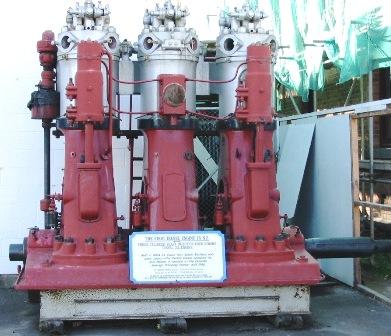New Zealand’s first diesel engine
Editor: Belinda Nevin
Editor: Alba Letts
In 1904 the Dunedin Drainage and Sewage Board imported two large diesel engines to drive the pumps in the city’s new Musselburgh Pumping Station, built to alleviate ongoing problems with drainage and sewage. Sulzer Brothers Ltd had made the engines that same year in Winterthur, Switzerland, and they were from just the second batch of engines manufactured by the company.
Sulzer Brothers worked with Rudolf Diesel, the inventor of the diesel engine, to develop their engines. Diesel had patented his idea in 1892 and worked with engineers at Mashinenfabrik Augsburg (MAN) in Munich, Germany, between 1893 and 1896 to perfect the first engine. After the design was proven to work, Sulzer bought a licence from Diesel and began manufacture.
The two engines, both the same type, were ordered for a price of 1,683 pounds each from the Diesel Engine Company in London, through their Dunedin agent, Ross & Glendinning Ltd. Diesel technology, and the Diesel Engine Company, promised significant economies of fuel consumption over steam engines. In a public lecture Mr JT Noble Anderson, the Drainage Board’s engineer, gave this economy as his reason for choosing the then new technology of diesel engines over existing and proven steam engine technology [1].
Steam engines were the dominant source of power for industry in New Zealand in 1904, and this diesel engine and its companion were the first in the country, indeed the first in the Southern Hemisphere [2]. Their purchase, coming soon after the compression ignition diesel system had been perfected, and then commercialised in 1897, represents an early adoption of a new technology and indicates significant faith on the Drainage Board’s part in the improved efficiency proclaimed for diesel engines. This willingness to harness new technology is particularly significant given there was no existing expertise in New Zealand in the maintenance and use of diesel engines, and the remoteness of such expertise from the country. Mr Peters, a representative from Sulzer, travelled to install the engines.
In June 1905 representatives of Dunedin and Otago local bodies and other prominent gentlemen were invited to witness a trial run of both engines at Musselburgh. This public trial run was the first time both engines, and the pumps they powered, were run together. Mr Anderson had tested the engines individually earlier, and in late May he reported the results of these trials to the Board; the engines had exceeded the manufacturer’s promises of efficiency and fuel economy, which had informed a limit set in the purchase agreement. If the engines exceeded this set limit for fuel consumption, then the Diesel Engine Company had to pay liquidated damages. If, however, the fuel consumption was below the set limit, the Drainage Board would pay an equivalent bonus. This provision in the purchase agreement was essentially a guarantee that the technology, as yet unseen in New Zealand, would be an improvement on the fuel efficiency of steam engine technology. The trials Mr Anderson ran resulted in a saving of 3.25 pounds of oil per engine against the standard of 50 pounds of oil per hour.
The trial of the two engines together was also a success, with water from the harbour brought into the sewer system and then successfully pumped to the outlet at Lawyer’s Head. Spectators were able to travel between the pumping station and the outlet on the day to see the water discharged.
The diesel engines were used at Musselburgh from 1905 until their replacement in the late 1950s. The forerunner of MOTAT, The Old Time Transport Preservation League, became aware that the two engines were to be scrapped and the Secretary, Peter Mellor, wrote to the Chairman of the Dunedin City Drainage Board in November 1958, asking whether one of the engines might be available for the League’s collection, then housed in Matakohe. The Secretary of the Drainage Board replied that they would be willing to donate one for exhibition purposes, in an “as is where is” condition, and that it must be removed as soon as possible. The other engine was scrapped by the Drainage Board and the metal sold to local foundries. The remaining engine was eventually shipped to Auckland in 1960 [3], with the manufacturer, Sulzer, and their then New Zealand agent, Clyde Engineering Company Ltd, each contributing $40 towards the shipping of the engine from Dunedin.
End notes:
1- Mr Anderson stated this publicly in a lecture given in Dunedin in December 1904; https://paperspast.natlib.govt.nz/newspapers/ODT19041215.2.60?end_date=15-12-1904&items_per_page=10&query=sewerage&snippet=true&start_date=15-12-1904&title=ODT Accessed 23/12/2019
2- https://paperspast.natlib.govt.nz/newspapers/ODT19041215.2.60?end_date=15-12-1904&items_per_page=10&query=sewerage&snippet=true&start_date=15-12-1904&title=ODT Accessed 23/12/2019
3- “Many historic machines are going on to the scrapheap”, Auckland Star, 2 April 1960, reprinted in Pointon, Ken, One Hundred Years of Diesel: New Zealand’s first diesel engine, 1905-2005.
References:
• Pointon, Ken, One hundred years of diesel: New Zealand's first diesel engine, 1905-2005, 2005, Auckland, MOTAT Museum of Transport and Technology.
• Stone, Harold. The Museum Makers, 1996, Matakohe, Otamatea Kauri & Pioneer Museum.
• http://www.swiss-ships.ch/berichte-buecher/berichte/Waertsilae/waertsilae_en.htm Accessed 15/11/2019

